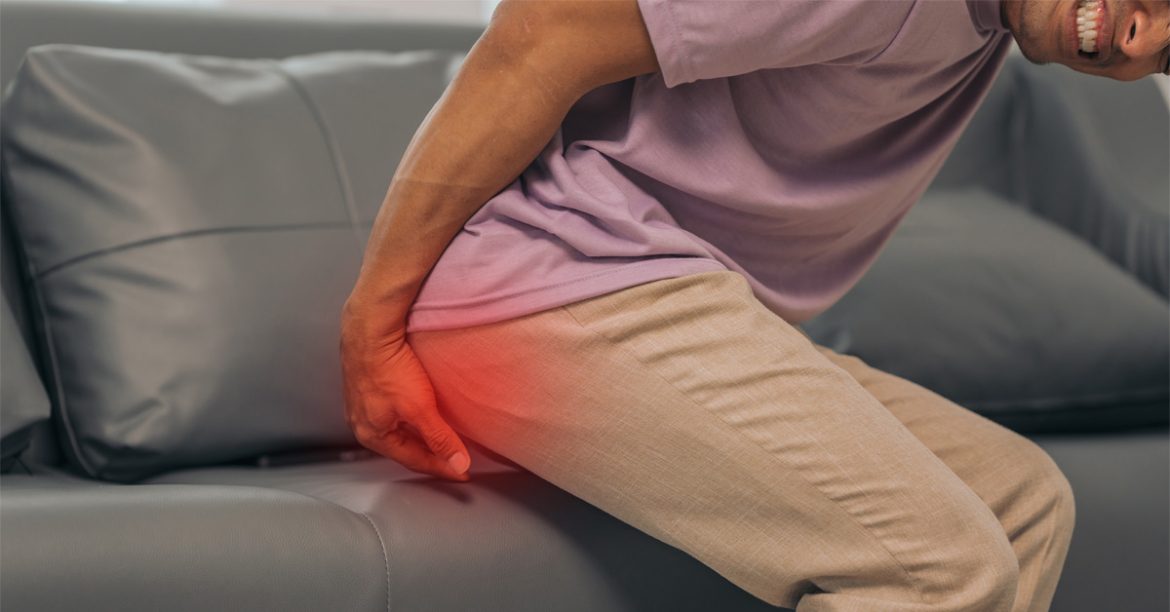Piriformis syndrome is a literal pain in the rear. It can be caused by both too much activity and too little. Runners and cyclists might experience it. But so can office works who sit a lot.
Whatever the cause, knowing piriformis syndrome symptoms and getting care can improve your quality of life.
What is the Piriformis Muscle?
The gluteus muscles are a group of three muscles located in the buttocks. These muscles support the lower body and help with walking, standing, and climbing stairs.
The largest of these muscles is the gluteus maximus.
The piriformis is a small muscle located deep within the buttock, behind the gluteus maximus. It helps stabilize the hip joint and allows you to rotate your leg outward.
The sciatic nerve runs from your lower back through your hips and buttocks and down each leg. The sciatic nerve is the longest nerve in your body. When it gets irritated or compressed, it can cause pain, tingling, or numbness along the nerve’s path.
Piriformis syndrome occurs when the piriformis muscle irritates the sciatic nerve.
In piriformis syndrome, the muscle spasms or tightens, putting pressure on the sciatic nerve. This pressure can cause symptoms similar to sciatica. So, it’s essential to tell the two apart for proper treatment.
((Insert image of Piriformis Syndrome anatomy – there are a couple of diagrams available on Shutterstock))
What to Watch For: Recognizing Piriformis Syndrome Symptoms
1. Persistent buttock pain
One of the main symptoms is a deep, aching pain in your buttocks. This pain can feel like mild discomfort or a more intense, throbbing sensation. It often gets worse after sitting or standing for a long time or after activities involving twisting your hip.
2. Radiating pain down the leg
The piriformis muscle is near the sciatic nerve. If it is swollen, it can put pressure on the nerve, leading to pain radiating down the back of your leg. Sometimes, it can reach all the way to the foot. This symptom is often mistaken for sciatica. But in piriformis syndrome, the pain comes from the buttock, not the lower back.
3. Numbness or tingling
You might experience numbness or tingling that starts in the buttock and travels down the leg. This may mean the piriformis muscle is compressing the sciatic nerve. It can cause changes in sensation in the affected areas.
4. Pain during movement
Certain movements like climbing stairs, squatting, or getting out of a car can worsen symptoms.
5. Worsening symptoms with sitting
Sitting for long periods, especially on hard surfaces, can put extra pressure on the piriformis muscle. Discomfort that improves when you stand up or lie down may be an indication.
6. Difficulty with hip rotation
This condition can make it harder for you to rotate your hip outward. You might feel stiffness or pain when moving your leg in certain ways, especially when turning it outward or crossing your legs.
Diagnosing Piriformis Syndrome
Getting an accurate diagnosis from your doctor is essential. They will usually start with a physical exam. They will assess your symptoms, review your medical history, and test your piriformis muscle. Sometimes, you may need imaging tests like an MRI or CT scan. They are done to rule out conditions like a herniated disc or spinal stenosis. These can cause similar symptoms.
Managing Piriformis Syndrome Symptoms
Your doctor will likely combine self-care with professional treatment. Treatment may include:
- Rest and activity modification. Avoiding activities that worsen pain, like sitting for long periods or heavy lifting.
- Alternating between ice and heat to reduce pain and relax muscles.
- NSAIDs. Medications like ibuprofen can help relieve pain and inflammation.
- Stretches to relieve tension in the piriformis muscle (hold each for 20 to 30 seconds):
- Piriformis: Lie on your back, cross one leg over the other, and pull the opposite leg towards your chest
- Figure-four: Sit, cross one leg over the other, and gently lean forward to stretch the muscle
- Seated piriformis: Sit in a chair, cross your ankle over the opposite knee, and lean forward
- Hip rotator: Lie on your back, cross one leg, and push the crossed knee down to stretch your hip
- Corticosteroid injections may be needed to reduce inflammation and relieve pain.
Get Expert Help
If you have piriformis syndrome and it affects your life, take action. Seeking care from an expert like a physiatrist or neurologist can get you back on track.
Don’t continue to live with the discomfort of piriformis syndrome – schedule an appointment today!
Don’t continue to live with lumbar spondylosis – today!



